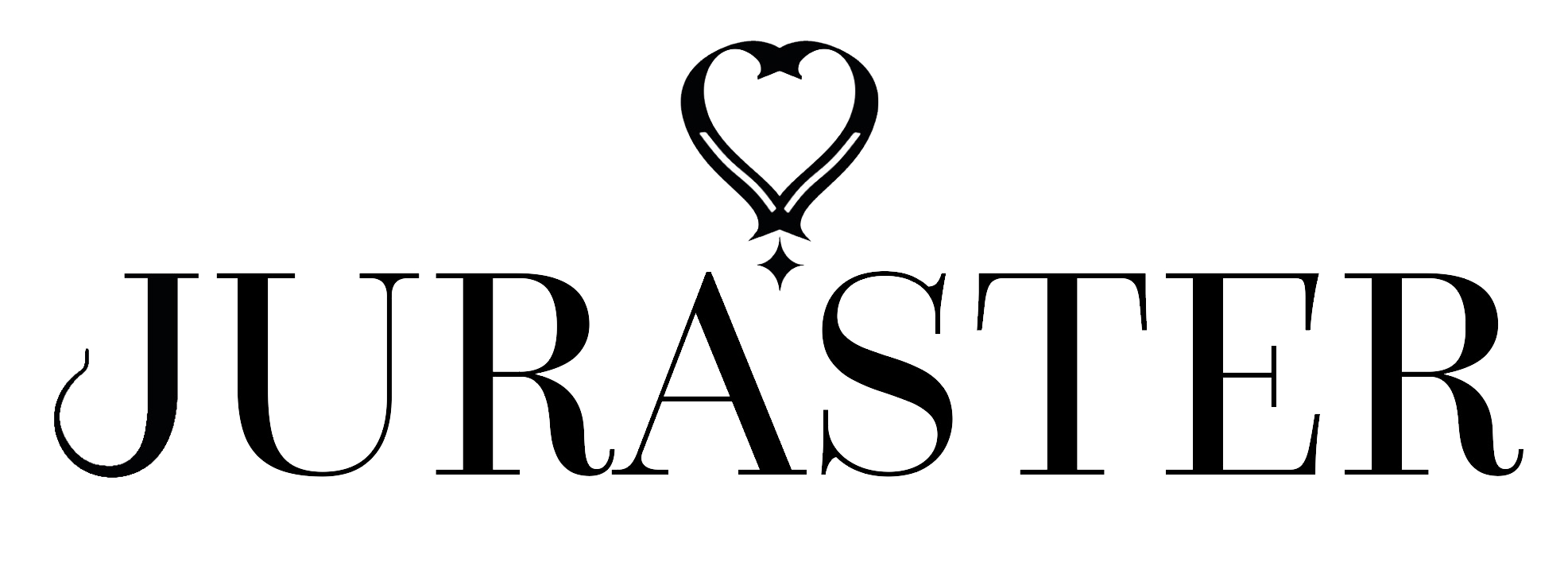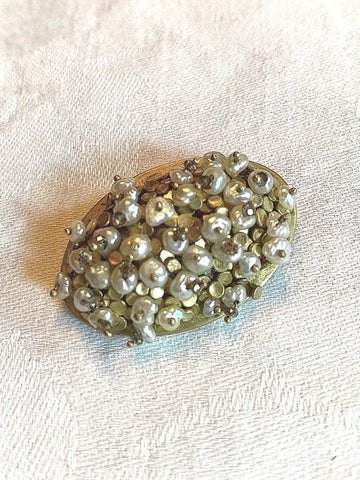Inside the Jewel Vault with Romilly Saumarez Smith
Listen Now
|
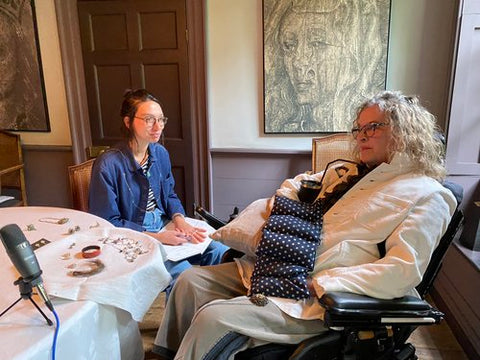 Romilly and Carola |
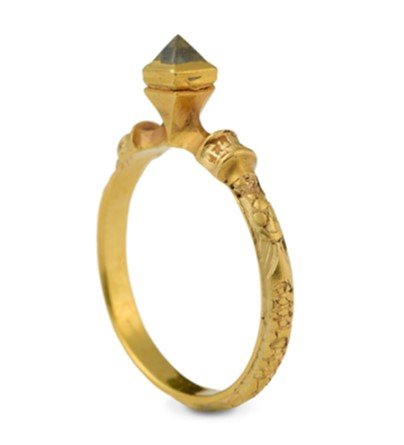 Medieval natural crystal diamond ring, photo time-line-co.uk |
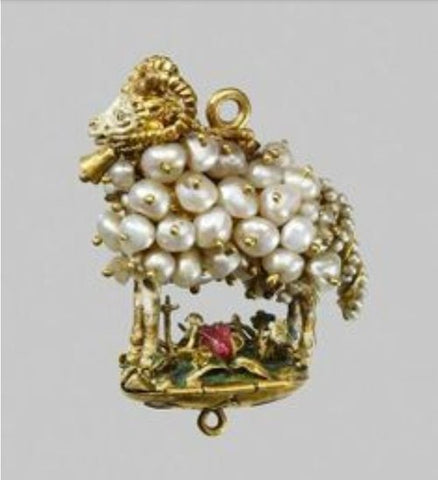 Pendant jewel ram covered in pearls. Photo c Trustees of British Museum. |
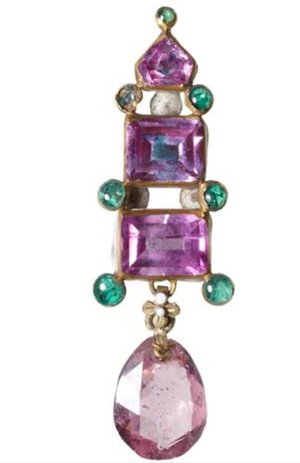 Pendant, amethysts emeralds pearl, Cheapside Hoard, photo Museum of London |
 Brooch silver & amber, Bettina Speckner, composition, date & photo credit unknown |
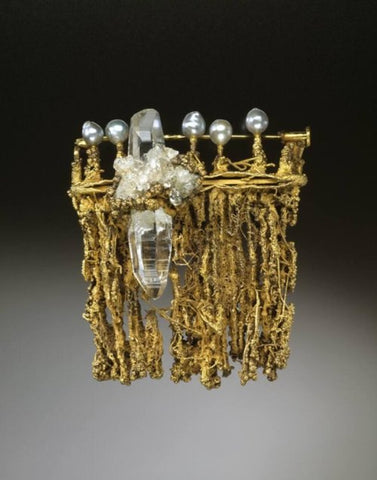 Stanley Lechtzin, Brooch 90-B, 1967, MFA Houston |
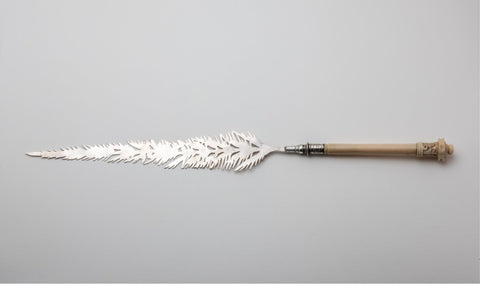
Paper Knife, Romilly Saumarez Smith 2020

RSS: What they do is two days one week and three days the next. Alternates. Laura did all the Treehandle work, because I know her imagination is sort of the most similar to mine, I suppose. Rachel can do anything, really, with jewellery. The work by Carola is called Newfoundland. Because it’s something that has been buried underground so it's “new-found-land”. So, it's been found, it’s found itself in a new place.
JCC: It was inspired originally by you walking over this amazing landscape.
RSS: I like playing with words. I don't like things to be shiny and I found it quite difficult at the beginning to persuade the jewellers that you don't always have to pickle things.
Carola: The first day, I remember I would pickle all the ‘Weeds’ and then I brought it in to Romilly to to show how I've done and was all white and not black. I was like ‘Oops’!
RSS: I suppose, I thought that some of the effects when you don't pickle are really nice.
JCC: And for you, Romilly, may I ask, what does jewellery mean for you?
RSS: Well, I always loved clothes, but jewellery was not a big thing. My mother used to buy me earrings, and so I remember she had a few funny pairs of earrings that I used to play with, and she had some nice pearls.
JCC: May I ask, where did you grow up and where was home for you?
RSS: Born in London. My father was a surgeon but came from a very artistic family. His, mother was a children's book illustrator, and his father was what would now be called an interior decorator. And he was also a furniture designer. Actually, my mother was a very good painter. So, I did come from quite an artistic background.
JCC: Artistic yes, a talented gene pool - artistic. And as a child, were you very expressive and creative?
RSS: Well, I used to draw a lot, but I used to do pages and pages of shoes. But I don't think I was particularly encouraged down that route. You know, I think my parents thought that I should get married, like the world was in those days
JCC: But did you pursue any further education after school?
RSS: Well, I was a very bad schoolgirl. I went to a lot of schools, none of which I liked, or they didn't like me. And when I left school, I worked in a bookshop called Hatchard’s.
JCC: Yes, I know, it well.
RSS: In the art department. And, I always loved books. I was a great reader. And I suppose actually what I wanted to be was a writer or a poet, more than a maker. But anyway, through Charles, who I'm now married to, who I met when I was very young, he encouraged me to go to do paper conservation. And I went to the course at Camberwell. And as part of the foundation we did book binding, that was where the book binding came in.
After Camberwell, I had to get a job, as a - I don't know, it would be a sort of journeyman. I was the first woman member of the men's branch of SOGAT, and it was a scary experience actually being there. But, on the other hand, at the beginning of the week, you were presented with fifty books on your bench and you got them done. And it was quite a good lesson in not being too precious about things. It was a year and then that was enough, really. And then I started, well, I think working in a slightly different way to my contemporaries. Fine binding had turned into a way of sort of interpreting the text. So, I think the books I made were particular structures. I used to play around a lot with dyeing the leather, and then building up layers and layers of different colour…

Romilly Saumarez Smith 1987, Theodore & Honoria. Photo The Crafts Council
JCC: Fascinating.
RSS: …which, I mean, it's sort of not that far away from what I would do with the patination now.
JCC: Yes, I can see the similes.
RSS: I started using metal on the books, because if you think of medieval bindings, they often had bosses. Anyway, I lived at that time in Newell Street in Limehouse. And opposite lived, a wonderful friend of mine, Cynthia Grant, and she is an incredibly talented maker of many things. And at the time, she was going to Morley College to learn how to make jewellery. And she said, oh, why don't you come and make jewellery? And I remember that afternoon I made my first pair of earrings, out of some copper wire. And that was sort of how it started. And I just loved it. I loved thinking about it. And I think being released from, the flatness of a book, to be able to think in the round. So I decided to take a year's sabbatical and I would see how I got on.
JCC: Really.
RSS: And, then I could go back to book binding if I wanted to. And I never went back
JCC: just like that!
RSS: But I never really thought I would be successful.I did 25 years as a book binder. And it's pretty well 25 years, really. Although I had a long break in the middle. Five-year break
JCC: With the hiatus.
RSS: Yes. So, it's been a split life really.
JCC: Right. Well, I think it's about time to go into your Vault. Tell me, what have you selected for us? There's six fantastic pieces in here, all quite different.

Medieval ring set with natural crystal diamond. Photo time-line.co.uk.
Learn more about this find by a metal detectorist in a Leicestershire field in 2008 - see Links at the end of this article.
RSS: Well, the first one is the medieval ring. And I suppose I like it because. I have a sort of romantic thing about how people used to use their diamond ring to scratch things onto glass. It's a natural crystal - diamond crystal - point set in gold. I suppose also I want to find one myself. But it goes back, I suppose, to my love of medieval things.
JCC: I love the way that the octahedron is set so high above the finger, it's almost sculptural.
RSS: Yes.
JCC: And then there's this carving around the shoulders either side. I mean, it looks to date about 13-1400’s, doesn't it?
RSS: It does.
|
Pendant jewel ram covered in pearls. Photo c Trustees of British Museum. |
Romilly Saumarez Smith brooch, studded with pearls |
JCC: So, the second piece we have in.
RSS: Here now, the second I suddenly realized that, of course, I do a lot of that with pearls. It's a strange ram. It's a religious thing. I think this is got a - you see at the bottom - it's got a cross. I'm not saying I copied the ram, but I liked it because he's doing the same thing as I've done, with my pearls. Again, I can relate that back to the book binding because when I um, was making these vellum books out of the cloth. If you imagine looking inside the cover, the corners I then stitched together. And one day when I was working in the Wellcome Library, I opened a vellum book, and that was exactly the same. So, I love the feeling that somebody in the past, that must be do you think late sixteneenth century maybe seventeenth century, someone then, has made the same technical decision of how to attach the pearls as I have.
JCC: In your brooch.
RSS: Yes.
JCC: So, again, it's very intriguing from your perspective just to try and understand how it's been made?
RSS: Finding that connection with a craftsperson that many hundreds of years ago, like I did with the book. I find that very moving, actually.

From the Cheapside Hoard, pendant of pink sapphires, emeralds, light pink briolette spinel and enamel. Photo Museum of London
JCC: So this third piece is now that's from the Cheapside Hoard.
JCC: What I love about it is the very bold colour combination.
RSS: Yeah.
JCC: Green and purple. It's a pale purple, like a lilac colour, isn't it?
RSS: Yes, it is.
JCC: And it's very zingy and not all quiet and restrained.

Bettina Speckner brooch, silver & amber. Photo credits unknown.
JCC: So I'd love to know what this fourth item in your vault is. There's a photograph and an orange gem that looks like it's in a setting of some sort.
RSS: Now she's a German jeweller called Betina Speckner. And to be honest, I almost can't bear to look at her work because I like it so much and I'm quite jealous of it!
JCC: Really. That’s very honest!
RSS: And I don't know anything much about her, but I just think she's brilliant and she uses, old photographs and I think she sometimes puts new photographs onto enamel and then adds a big gem to it. Funny enough I would say it's not terribly wearable! But I just think it's fantastic. And as I say I just don't really want to look at it because I don't - to put it… well I am envious but obviously it's not like my work but I don't want it to infect my work .
JCC: I see so it's got to go into quarantine.
JCC: it's interesting having talked to you a little bit before and you said that people were copying you which you don't mind
RSS: I.don't mind because I can always go on .
JCC: Yeah because to you the horizon is limitless whereas people are only just catching up to where you are you're expanding .
RSS: wellI used to find that with book binding that I could always see where their influences came from, I don't mind. I know if I could use a mobile phone I would be just as addicted to Instagram as everyone else is, but I think it's - I'm very glad I can't because I don't want to be - my mind to be - full of other people's images. And I think it is quite dispiriting sometimes - well, it's a difficult thing, isn't it? But image after image after image and people looking for sort of less than a second. But the Bettina Speckner thing is slightly different to that I just don't want to look too much.
It won't give me ideas but maybe I feel I ought to be, I would like to be more like that but I'm not. I think she's a genius. Anyway - if I was to choose to go in another direction I would love it to be something like that, but of course it never would be because I would never copy anybody. As soon as I think of somebody that I want to do something that someone else has done I would never - I would always stay away from it.
JCC: Of course, yeah. But what is it you like about this piece – it’s a photograph of some unknown young woman with her cheeks rouged it's black and white.
RSS: Funnily enough, again, I’ve only just thought of it but there are two things in the house, if you look behind you at the other end of the mantel and if you go next door I don't know if you noticed, there's a picture of a photograph of a boy with rouged cheeks and of course I hadn't realized that until now!
JCC: So, I've never seen anything quite like this myself and certainly nobody else has chosen Bettina Speckner. It's always wonderful to know of a new name.

Bettina Speckner brooch 90-B, 1967, collection & photo credit MFA Boston
JCC: So item number five is by Stanley - how do I say his name? Lechtzin?
RSS: I have no idea!
JCC: Stanley Lechtzin and it's a pin or a brooch of some sort.
RSS: Brooch. I've looked at other pieces of his work and I don't like any of them, but I love this piece. I also realized when I put them together that they're two large lumps, that's the crystal do you see hanging off the front which is inequivalent to what Bettina Speckner is doing and it's got the pearls again and I think it's electroplated. I think they must be bits of sort of string or cotton that could be it electroplated.
JCC: It is that what they are?
RSS: I don't know. What do you think?
JCC: I was hoping you would tell me!
RSS: Everything else he does that I've seen I really dislike but I like this piece. When I saw it, I thought, God, I wish I'd made that myself.
JCC: Really?
JCC: Yeah. I just think it's fantastic. Yeah he's working in the 60’s, I love a lot of that the 60s work. I could have found one of the Andrew Grima pictures that I like I couldn't find any of the ones that I really like but I love his work.
JCC: This is like, uh, a semi destroyed Andrew Grima piece.
RSS: Yes it really is. I mean, again, it would be horrible to wear. I suppose there's probably about life-size.
JCC: Enormous, then.
RSS: I think so.

Paper Knife by Romilly Saumarez Smith, 2020
JCC: And then finally, the sixth piece is one of your own, isn't it?
RSS: Okay, well, this is the piece I'm most proud of.
JCC: And it’s here before us.
RSS: It's called Paper Knife. And it was part of the Treehandle collection. And I spent, like I do, to find all sorts of things, spent many hours on eBay finding different cutlery handles. And this is an amazing pickle handle. They used to use pickle forks and pickle knives and pickle spoons to get their gherkins out of - Victorian, in Victorian times. And I just think it's amazing it looks like a sort of design by Pugin.
JCC: Yes!
RSS: So, I wanted to do something very special with it. And we went to the new Islamic gallery at the British Museum, and there's an open album made by a nineteenth century Persian woman. And there was cut out of pink tissue paper there was this shape of a Cyprus tree. And we took a picture of the Cyprus tree, and I had Laura pierce out the shape in silver. So, it has a strange relationship. It's probably about the same time in the nineteenth century. But one thing comes from Persia, and one is obviously very English. And they're now joined together.
JCC: Yes.
RSS: And I like the surreal nature because I named it Paper Knife, which obviously, you could never use those paper knives, but it's called Paper Knife because the original was made from pink paper.
JCC: Right, I see. And you're playing with words.
RSS: Yes. Again.
JCC: Well, it's very beautiful. I love the idea of the fact that you've literally forged two totally different ways of looking at the world.
RSS: Yes.
JCC: Well, out of your vault of six beautiful things that you have here, you’ve got your natural diamond crystal set into an early medieval ring, then you’ve got this historical ram, with the pearls set just like you would, and the Cheapside Hoard earring or pendant tassel made of emeralds and amethysts, you’ve got your Bettina Speckner brooch and your extraordinary Stanley Lechtzin pin, and your very own Paper Knife. So, out of these six fantastic pieces in your vault, if you had to only keep one safe, which would it be?
RSS: I think - it's very hard! I wouldn’t keep the ring. I wouldn't keep the ram, and I wouldn't keep my own. So it would be between the three. I'm curiously, I think I might keep the Stanley because it's so bizarre and wonderful.
JCC: So that's the piece you would save?
RSS: Yeah. That's going into the Vault.
JCC: Yeah. Wonderful. What an extraordinary choice, though. But one that would keep you intrigued.
RSS: It would. And I could find out how it was made!
JCC: Yes, you could study it. Well, Romilly, it's been a fantastic vault. Thank you so much for all of the stories and techniques that you shared.
RSS: Thank you. I enjoyed it.
-Ends-
Links:
Romilly Saumarez Smith website - https://www.romillysaumarezsmith.com/about
Item 1 - Medieval ring set with natural diamond crystal. Read the extraordinary story of this ring’s discovery: https://www.dailymail.co.uk/news/article-1047349/Treasure-hunter-finds-11th-century-gold-ring-rare-black-diamond-muddy-field.html
The Cheapside Hoard - https://www.museumoflondon.org.uk/discover/cheapside-hoard-collection-focus
Historical ram pendant from the British Museum collection - https://www.britishmuseum.org/collection/object/H_WB-166
Bettina Speckner - https://www.bettina-speckner.de/
Stanley Lechtzin - https://emuseum.mfah.org/objects/61940/brooch-90b;jsessionid=B005B3871AF7CE518402C05B32E76833
Romilly Saumarez Smith Treehandles https://static1.squarespace.com/static/56545072e4b019da21bec05d/t/5fd8d8fc0cb5764bbd536764/1608046846523/Treehandles+edit.pdf

